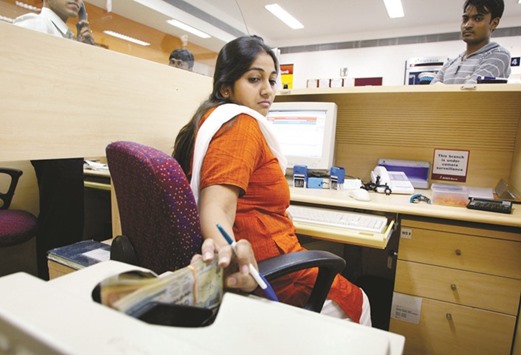The top forecasters for the rupee aren’t convinced the currency can sustain its rebound from the brink of a record low in February.
The currency will decline to an unprecedented 69.50 per dollar by the end of the year, 3.5% weaker than its close in Mumbai yesterday, according to Kotak Mahindra Bank, which had the most accurate estimates in Bloomberg’s quarterly rankings. Credit Agricole CIB, placed second, predicts a slide to 70.
While Finance Minister Arun Jaitley said India stood out as a safe haven after Britain’s decision to exit the European Union, investors are anxious about knock-on effects on the continent and the global economy.
The UK’s share in India’s overseas shipments is 3.5% and the rest of the EU accounts for about 13.5%, according to Nomura Holdings. Exports from Asia’s third-largest economy have fallen for 18 straight months.
“The pressure we are seeing on the rupee is on account of what is happening across the world,” said Phani Shankar, senior executive vice-president for treasury at Kotak Mahindra Bank in Mumbai. “There’s a fair bit of uncertainty post Brexit and there is a bit of a cloud over its consequences for some of the Indian exporters.”
The rupee sank to 68.7875 a dollar in February, near an all-time low of 68.8450 seen in 2013. The currency, which rose 0.2% yesterday, has rallied 2.6% since then as the Indian government’s budget discipline revived investor confidence in local assets.
Brexit “is likely have an adverse impact on India’s growth through trade and financial channels,” though much less than more open economies, Morgan Stanley wrote in a report after the UK’s June 23 vote.
Further risks to the currency come from accelerating inflation and the impending departure of Reserve Bank of India Governor Raghuram Rajan, who helped restore market stability after taking charge within days of the rupee’s tumble to a record in 2013.
“We are negative on the rupee due to Rajan’s exit, the central bank’s policy to depreciate the currency to support weak exports and still elevated inflation,” said Dariusz Kowalczyk, a Hong Kong-based senior emerging-market strategist at Credit Agricole. “He’s stabilised the market and built a lot of credibility. It will be difficult for his replacement to match him.”
Rajan will leave the central bank when his term ends early September, after a member of Prime Minister Narendra Modi’s ruling party publicly criticised him for keeping rates unnecessarily high. His successor faces the challenge of keeping inflation under check, given the central bank’s target to limit price gains to 5% by March 2017, while maintaining currency stability amid the fallout from Brexit and a potential increase in US interest rates.
The new RBI chief will also have to contend with an estimated $20bn outflow from maturing foreign-currency deposits that Rajan had lured to support the currency back in 2013.
Rupee sovereign bonds rallied the most since early April on Tuesday as speculation mounted that the yet-to-be-named new governor will be more aggressive in monetary easing.
A successor to Rajan may be named soon, the CNBC television channel said on Tuesday, following a report by Bloomberg TV India on Monday that Arvind Panagariya, vice chairman of a policy research group established by Modi, was the top contender for the job. The notes extended gains yesterday, taking the 10-year yield to its lowest close since June 2013.
BlackRock is overweight on India’s local-currency debt, Scott Thiel, deputy chief investment officer for fundamental fixed income at the world’s largest asset manager, said in London on Tuesday, as overseas investors added Rs16.9bn to their holdings of Indian government and corporate securities. That’s the biggest single-day increase since March 30, National Securities Depository Ltd data show.
Kotak Mahindra’s Shankar said global volatility and not domestic factors are contributing to its view on rupee depreciation, adding that India’s overall economic fundamentals are good and inflation isn’t “running away.” Futures contracts signal there’s a 34% probability the Federal Reserve will raise rates by year-end, up from 8% on July 5, suggesting a resilient US economy may dim the allure of rupee assets.
“The biggest risk to us will be how the global uncertainty plays out and whether it translates into dramatic shifts of capital and significant dollar strength,” Shankar said. “In times of uncertainty, pressure usually transfers to the rupee in some form or the other.”

A cashier at the ICICI bank branch in New Delhi places rupee notes in a counting machine. The Indian currency will decline to an unprecedented 69.50 per dollar by the end of the year, 3.5% weaker than its close in Mumbai yesterday, according to Kotak Mahindra Bank.
